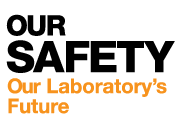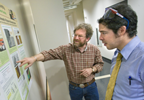



The UC Police Department has increased their traffic patrols at the Lab in an effort to improve safety. Those who violate the California Vehicle Code for driving and parking will be cited and ticketed. The patrols, which started a few months ago, have helped reduce incidents involving cars, bicycles and pedestrians, some of which resulted injury. In addition to speeding and running stop signs, tickets will be issued to cars that are parked in motorcycle spaces, red zones, and handicap spaces without authorization, or are blocking fire hydrants or other vehicles (except in stacked parking lots).
Go to OurSafety for more on the Lab's safety efforts.
 Construction for the Seismic Phase I Project will start tomorrow. The contractor will begin installation of a perimeter fence around Building 50 and launch other mobilization activities. Current parking areas around the building will be revised this evening. The contractor will also be using parking near Building 74. Go here to view the laydown plans for 50 and 74. For more information, contact Jack Heffernan (x5993) or Doug Brunkow (x6252).
Construction for the Seismic Phase I Project will start tomorrow. The contractor will begin installation of a perimeter fence around Building 50 and launch other mobilization activities. Current parking areas around the building will be revised this evening. The contractor will also be using parking near Building 74. Go here to view the laydown plans for 50 and 74. For more information, contact Jack Heffernan (x5993) or Doug Brunkow (x6252).
External network connectivity to the Lab will be interrupted between 5:30 and 7:30 p.m. this evening due to ESnet network maintenance. External access to Lab IT services, such as e-mail, web, and calendar, as well as e-mail sent to or from offsite computers will be impacted. There will be no impact to internal Lab IT services.
 [Chemistry World] During pregnancy the mammary gland goes through changes which suggest the tissue contains a reservoir of undifferentiated cells — cells that can convert into more specialized types. The researchers — led by Berkeley Lab life scientist Mary Helen Barcellos-Hoff — built a computational microscopy platform that will allow them to understand how cells are affected by different microenvironments within the same tissue. More>
[Chemistry World] During pregnancy the mammary gland goes through changes which suggest the tissue contains a reservoir of undifferentiated cells — cells that can convert into more specialized types. The researchers — led by Berkeley Lab life scientist Mary Helen Barcellos-Hoff — built a computational microscopy platform that will allow them to understand how cells are affected by different microenvironments within the same tissue. More>
 In The News: Star Light, Star Bright, Its Explanation is Out of Sight
In The News: Star Light, Star Bright, Its Explanation is Out of Sight[Innovations] This pair of NASA Hubble Space Telescope pictures shows the appearance of a mysterious burst of light that was detected in February of 2006, brightened over 100 days, and then faded into oblivion after another 100 days. The source of the outburst remains unidentified. The event was detected serendipitously in a Hubble search for supernovae in a distant cluster of galaxies. The light-signature of this event does not match the behavior of a supernova or any previously observed astronomical transient phenomenon in the universe. Therefore, this observation defies a simple explanation, reports Kyle Barbary, with Berkeley Lab’s Physics Division. More>
The Joint Genome Institute, through its Community Sequencing Program, is soliciting proposals related to the Department of Energy’s missions of bioenergy, global carbon cycling and biogeochemical processes influencing contaminant transport. Targets include bacterial and archaeal isolates, large-scale eukaryotic or bacterial resequencing efforts that exploit next-generation sequencing technologies, eukaryotic reference genomes, and environmental microbial genomes (metagenomes). Letters of intent are due Jan. 30. More>
 Lab Guest: Chris Magana, Rep for Congressman Jerry McNerney
Lab Guest: Chris Magana, Rep for Congressman Jerry McNerneyLast Thursday, Chris Magana (right), field representative for U.S. Congressman Jerry McNerney, visited Berkeley Lab for a brief tour and to attend a lecture on fusion energy hosted by Andy Sessler (Accelerator and Fusion Research Division) and Physics Division Director Jim Siegrist. While here, Magana toured the Molecular Foundry with Ron Zuckermann (left), deputy director for the Biological Nanostructures Facility, the Transmission Electron Aberration-Corrected Microscope at NCEM, and the Advanced Light Source. Representative McNerney visited the Lab on Dec. 2 and participated in the dedication of the Joint BioEnergy Institute.